|
|
 |
Theodore Gericault
|
|
French Romantic Painter, 1791-1824
was a profoundly influential French artist, painter and lithographer, known for The Raft of the Medusa and other paintings. Although he died young, he became one of the pioneers of the Romantic movement. Born in Rouen, France, Gericault was educated in the tradition of English sporting art by Carle Vernet and classical figure composition by Pierre-Narcisse Guerin, a rigorous classicist who disapproved of his student's impulsive temperament, but recognized his talent.[1] Gericault soon left the classroom, choosing to study at the Louvre instead, where he copied from paintings by Peter Paul Rubens, Titian, Diego Velezquez, and Rembrandt for about six years, from 1810 to 1815. |
|
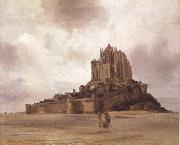 |
Theodore Gudin
|
|
French Painter, 1802-1880
was a French painter of the 19th century. He especially painted navy scenes, and was a pupil of Girodet-Trioson. Gudin was one of the first Peintres de la Marine, at the court of Louis-Philippe and Napoleon III. |
|
 |
Thomas Cooper Gotch
|
|
1854-1931
English
Thomas Cooper Gotch Gallery
In Newlyn he worked first at painting local scenes in the then-fashionable realist manner. But even these often had a romantic edge, such as The Wizard or an obvious love of surface colour.
In 1891 a visit to Florence, Italy, opened his eyes to the work of the romantic European symbolists. He took the brave step of changing his style, to make romantic decorative paintings, when the prevailing fashion was against him. His first work in this new style was My Crown and Sceptre (1892), which was the progenitor to his most well-known work The Child Enthroned (1894). The latter, on original exhibition, was hailed by The Times newspaper as the star of that year's Royal Academy show. Until that time, his new style of work had drawn much critical scorn.
He painted religious Christian scenes, history painting, portraits, and a few landscapes. His best-known paintings, which form the bulk of his work, usually portray girl-children in ornate classical or medievalist dress. The appearance of the girls in his paintings is often noted as being very modern. Gotch was a close and lifelong friend of Henry Scott Tuke, whose work featured a parallel focus on the boy-child. Gotch's lifelong adoration of the beautiful girl-child was shared by other Victorian giants such as John Ruskin and Lewis Carroll.
His emotionally-charged work was immensely popular and critically acclaimed for most of his life, although interest in neo-romanticism waned after the First World War and he turned to watercolours of flowers. He also illustrated books, such as Round About Wiltshire, The Land of Pardons (an early study of Breton folklore & Celtic Christianity), and contributed illustrations to school readers such as Highroads of Literature.
A retrospective show was held in Newcastle in 1910, and a memorial exhibition in Kettering in 1931. |
|
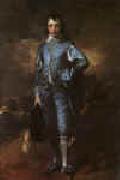 |
Thomas Gainsborough
|
|
1727-1788
British
Thomas Gainsborough Locations
English painter, draughtsman and printmaker. He was the contemporary and rival of Joshua Reynolds, who honoured him on 10 December 1788 with a valedictory Discourse (pubd London, 1789), in which he stated: If ever this nation should produce genius sufficient to acquire to us the honourable distinction of an English School, the name of Gainsborough will be transmitted to posterity, in the history of Art, among the very first of that rising name. He went on to consider Gainsborough portraits, landscapes and fancy pictures within the Old Master tradition, against which, in his view, modern painting had always to match itself. Reynolds was acknowledging a general opinion that Gainsborough was one of the most significant painters of their generation. Less ambitious than Reynolds in his portraits, he nevertheless painted with elegance and virtuosity. He founded his landscape manner largely on the study of northern European artists and developed a very beautiful and often poignant imagery of the British countryside. By the mid-1760s he was making formal allusions to a wide range of previous art, from Rubens and Watteau to, eventually, Claude and Titian. He was as various in his drawings and was among the first to take up the new printmaking techniques of aquatint and soft-ground etching. Because his friend, the musician and painter William Jackson (1730-1803), claimed that Gainsborough detested reading, there has been a tendency to deny him any literacy. He was, nevertheless, as his surviving letters show, verbally adept, extremely witty and highly cultured. He loved music and performed well. He was a person of rapidly changing moods, humorous, brilliant and witty. At the time of his death he was expanding the range of his art, having lived through one of the more complex and creative phases in the history of British painting. He painted with unmatched skill and bravura; while giving the impression of a kind of holy innocence, he was among the most artistically learned and sophisticated painters of his generation. It has been usual to consider his career in terms of the rivalry with Reynolds that was acknowledged by their contemporaries; while Reynolds maintained an intellectual and academic ideal of art, Gainsborough grounded his imagery on contemporary life, maintaining an aesthetic outlook previously given its most powerful expression by William Hogarth. His portraits, landscapes and subject pictures are only now coming to be studied in all their complexity; having previously been viewed as being isolated from the social, philosophical and ideological currents of their time, they have yet to be fully related to them. It is clear, however, that his landscapes and rural pieces, and some of his portraits, were as significant as Reynolds acknowledged them to be in 1788. |
|
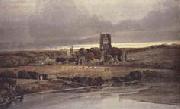 |
Thomas Girtin
|
|
English Romantic Painter, 1775-1802
English painter, draughtsman and printmaker. With his rival, J. M. W. Turner, he extended the technical possibilities of watercolour and in doing so demonstrated that watercolours could have the visual impact and emotional range of oils. Although close in style throughout the 1790s, by 1800 Turner and Girtin were beginning to diverge: whereas the former dissolved forms to express his idea of Nature in a state of flux, the latter sought out a landscape's underlying patterns to convey his awe of Nature's permanence as well as its grandeur. Girtin's reduction of landscape to simple and monumental forms |
|
|
|
|
|
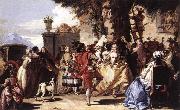 |
TIEPOLO, Giovanni Domenico
|
|
Italian painter, Venetian school (b. 1727, Venezia, d.
1804, Venezia).
Italian painter and printmaker. He was apprenticed to his father, Giovanni Battista Tiepolo, in Venice in the early 1740s and worked with him in Madrid from 1762 until the elder's death in 1770. His most notable early works are the chinoiserie decorations of the Villa Valmarana in Vicenza (1757). Back in Venice, he executed several frescoes and paintings of scenes from the commedia dell'arte. A talented genre painter and caricaturist, he was famous for his many engravings and etchings after his own and his father's designs.
|
|
 |
TRAVERSI, Gaspare
|
|
Italian Painter, ca.1722-1770
Italian painter. He was apprenticed to the elderly Francesco Solimena, whose late style, a reinterpretation of the Baroque art of Mattia Preti, influenced his earliest works. At the same time he studied the naturalist painters of the 17th century: Preti himself, Giovanni Battista Caracciolo, Jusepe de Ribera, Filippo Vitale and Francesco Fracanzano. Classical art also attracted him, and in the 1740s he began to make journeys to Rome to study the influential works of Bolognese and Roman classicism: paintings by Guido Reni, Guercino and the Carracci family, and by Carlo Maratti. During one of these visits he copied two pictures by Maratti, then in S Isidoro, Rome: the Flagellation and a Crucifixion . In the following year he was in Naples; three canvases of scenes from the Life of the Virgin (Naples, S Maria dell'Aiuto), one of which is signed and dated 1749 |
|
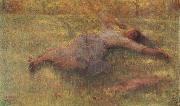 |
Tudor St George Tucker
|
|
1862 - 1906,was the son of Captain Charlton Nassau Tucker, a cavalry officer in the East India Company's service. He came to Melbourne in 1881. He studied at the national gallery school and afterwards at Paris. He returned to Melbourne and about the year 1893 was associated with E. Phillips Fox in the conduct of the Melbourne art school. He was back in London in 1899 working in a studio at Chelsea, and had two paintings in the 1900 Royal Academy exhibition, two in 1901 and one in 1902. He died in London in 1906. He suffered much from ill health and his work is comparatively little known. |
|
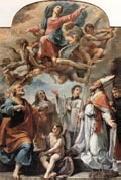 |
Ubaldo Gandolfi
|
|
Italian Painter, San Matteo della Decima, 1728 - Ravenna, 1781
was an Italian painter of the late-Baroque period, mainly active in and near Bologna. He was born in San Matteo della Decima and enrolled by the age of 17 at the Clementine Academy, where he apprenticed with Ercole Graziani the Younger, Felice Torelli, and Ercole Lelli. He was from a large family of prolific artists, including his sons Giovanni Battista and Ubaldo Lorenzo, as well as his brother Gaetano and nephews Mauro, Democrito (who became a pupil of Antonio Canova), and niece Clementina. Together, they are considered the last representative of the grand manner of painting characteristic of the Bolognese school, that had risen to prominence nearly two centuries earlier with the Carracci. Gandolfi's work ranges from Baroque to Neoclassic styles, and specifically recalls the style of Ludovico Carracci. He completed, in 1770-75, a series of canvases on mythological narratives for the Palazzo Marescalchi in Bologna (two are now in Museum of North Carolina ). He died in Ravenna in 1781. |
|
|
|
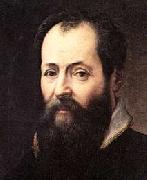 |
VASARI, Giorgio
|
|
Italian Mannerist Writer and Painter, 1511-1574
Italian painter, architect, and writer. Though he was a prolific painter in the Mannerist style, he is more highly regarded as an architect (he designed the Uffizi Palace, now the Uffizi Gallery), but even his architecture is overshadowed by his writings. His Lives of the Most Eminent Architects, Painters, and Sculptors (1550) offers biographies of early to late Renaissance artists. His style is eminently readable and his material is well researched, though when facts were scarce he did not hesitate to fill in the gaps. In his view, Giotto had revived the art of true representation after its decline in the early Middle Ages, and succeeding artists had brought that art progressively closer to the perfection achieved by Michelangelo. |
|
|
|
Vicente Palmaroli Gonzalez
|
|
1834-1896
Spanish
Vicente Palmaroli Gonzalez Gallery
His father was the Italian lithographer, Gaetano Palmaroli and he studied in San Fernando's Royal Academy. He later went to Rome in 1857 to complete his training, and he lived there until 1866. One year later, he went to the Paris World's Fair of 1867. He met Ernest Meissonier, who influenced his later works.
He was academician in San Fernando's Royal Academy, and director in the Spanish Academy in Rome and Prado Museum (1893-1896). |
|
|
|
|
|
|
|
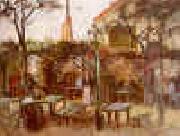 |
Vincent Van Gogh
|
|
Dutch Post-Impressionist Painter, 1853-1890
Vincent Willem van Gogh (30 March 1853 ?C 29 July 1890) was a Dutch Post-Impressionist artist. Some of his paintings are now among the world's best known, most popular and expensive works of art.
Van Gogh spent his early adult life working for a firm of art dealers. After a brief spell as a teacher, he became a missionary worker in a very poor mining region. He did not embark upon a career as an artist until 1880. Initially, Van Gogh worked only with sombre colours, until he encountered Impressionism and Neo-Impressionism in Paris. He incorporated their brighter colours and style of painting into a uniquely recognizable style, which was fully developed during the time he spent at Arles, France. He produced more than 2,000 works, including around 900 paintings and 1,100 drawings and sketches, during the last ten years of his life. Most of his best-known works were produced in the final two years of his life, during which time he cut off part of his left ear following a breakdown in his friendship with Paul Gauguin. After this he suffered recurrent bouts of mental illness, which led to his suicide.
The central figure in Van Gogh's life was his brother Theo, who continually and selflessly provided financial support. Their lifelong friendship is documented in numerous letters they exchanged from August 1872 onwards. Van Gogh is a pioneer of what came to be known as Expressionism. He had an enormous influence on 20th century art, especially on the Fauves and German Expressionists. |
|
|
|
|
|
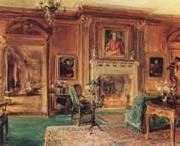 |
Walter Gay
|
|
1856-1937. He was an American painter born at Hingham, Massachusetts. He married heiress Matilda E. Travers, the daughter of prominent New York City investor and co-founder of Saratoga Race Course, William R. Travers. In 1876 the couple moved to Paris, France where Walter Gay became a pupil of Leon Bonnat. They lived in an apartment on the Left Bank and in 1907 purchased Chateau Le Breau on a three-hundred-acre walled park near the Forest of Fontainebleau. Walter Gay received an honorable mention in the Paris Salon of 1885; a gold medal in 1888, and similar awards at Vienna (1894), Antwerp (1895), Berlin (1896) and Munich (1897). He became an Officer of the Legion of Honor and a member of the Society of Secession, Munich. |
|
 |
Walter Gramatte
|
|
Walter Gramatte (8 January 1897 in Berlin - 9 February 1929 in Hamburg) was a German expressionist painter who specialized in magic realism. He often painted with a mystical view of nature.
Walter Gramatte died on 9 February 1929 of Intestinal Tuberculosis.
His second wife Sonia married again, was then named Sophie Carmen Eckhardt-Gramatte and lived in Canada as a renowned musician. To remember her and her former husband Walter Gramatte „The Eckhardt-Gramatte-Foundatione was established in Winnipeg, Canada.
Walter Gramatte's written posthumous works are preserved in the German National Museum.
A special exhibition of his paintings, titled Rediscovered: Walter Gramatte 1897-1929, took place in Hamburg Ernst Barlach Haus from October 26, 2008 to February 1, 2009. This exhibition was organized by Kirchner Museum in Davos, Switzerland and the Ernst Barlach Haus in Hamburg, Germany.
|
|
|
|
 |
Walter Griffin
|
|
1861-1935
Walter Burley Griffin November 24, 1876?CFebruary 11, 1937) was a US architect and landscape architect, who is best known for his role in designing Canberra, Australia's capital city. He has also been credited with the development of the L-shaped floor plan, the carport and the first use of reinforced concrete.
Influenced by the Chicago-based Prairie School, Griffin went on to develop a unique modern style. For much of his career Griffin worked in partnership with his wife Marion Mahony Griffin. In the 28 years of their architectural partnership, the Griffins designed over 350 building, landscape and urban-design projects as well as designing construction materials, interiors, furniture and other household items. |
|
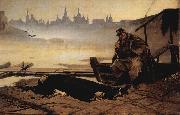 |
Wassilij Grigorjewitsch Perow
|
|
Vasily Grigorevich Perov (Russian; real name Vasily Grigorevich Kridener ; 2 January 1834 (21 December 1833 Old Style) - 10 June (29 May Old Style) 1882) was a Russian painter and one of the founding members of Peredvizhniki, a group of Russian realist painters.
Vasily Perov was born 2 January 1834 (21 December 1833 Old Style) in Tobolsk, being the illegitimate son of procurator, baron Grigory Karlovich Kridener. After completing a course at Arzamas uezd school, he was transferred to the Alexander Stupin art school also located in Arzamas. In 1853 he was admitted to the Moscow School of Painting, Sculpture and Architecture, where he learned from several renowned artists.
In 1856 he was awarded with a minor silver medal for his sketch of a boy's head, presented to the Imperial Academy of Arts. Later the Academy gave him many other awards: in 1857 a major silver medal for Commissary of Rural Police Investigating, a minor golden medal for the Scene on a Grave and the Son of a Dyak Promoted to First Rank, and in 1861 a major golden medal for Sermon in a Village.
After receiving the right to a state-paid trip abroad together with a golden medal, in 1862 Perov went to Western Europe, visiting several German cities, and then Paris. During this time he created paintings depicting scenes from European street life, such as the Vendor of statuettes, the Savoyard, the Organ-Grinder in Paris, the Musicians and the Bystanders, and the Paris Ragpickers.
Returning to Moscow early, from 1865 to 1871 Perov created his masterpieces The Queue at The Fountain, A Meal in the Monastery, Last Journey, Troika, the Lent Monday, Arrival of a New Governess in a Merchant House, the Drawing Teacher, A Scene at the Railroad, the Last Tavern at Town Gate, the Birdcatcher, the Fisherman, and the Hunters at Rest.
|
|
|
|
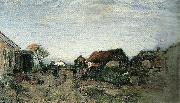 |
wilhelm von gegerfelt
|
|
född 9 november 1844 i Göteborg, död 1920, målare, son till arkitekten Victor von Gegerfelt.
von Gegerfelt studerade 1861-63 vid konstakademien i Köpenhamn, 1864-67 vid akademien i Stockholm och 1867-72 i D??sseldorf, varefter han överflyttade till Paris. Där arbetade han sig till en helt ny teknik och blev jämte Alfred Wahlberg den förste svenske representanten för det moderna stämningslandskapet. Han gjorde studieresor till Frankrikes nordkust, till hemlandet och till Italien, målade skymning över Venedigs kajer, månsken över lagunerna, kritklippor vid Engelska kanalen i gråstämning, svenska sommarnätter, allt med elegant pensel, smekande färg och livligt föredrag. Gegerfelt är representerad på Nationalmuseum av Stormen (akvarell, motiv från Dalarna, inköpt 1886) och Strand på Hallands Väderö (i olja, 1893) samt på Göteborgs konstmuseum av Strandgata i Venezia (1884), oljemålningen Vinterafton på Hallands Väderö (1893) samt akvarellen Fjällbacka. |
|
|
|
|
|
|
|
|
|
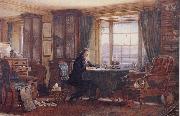 |
William Gershom Collingwood
|
|
artist and historian, (1854-1932)
was an author, artist, antiquary and was also Professor of Fine Arts at the Reading University. He was born in Liverpool. In 1872, he went to University College, Oxford, where he met John Ruskin. During the summer of 1873 Collingwood visited Ruskin at Brantwood, Coniston. Two years later Collingwood was working at Brantwood with Ruskin and his associates. Ruskin admired his draughtsmanship, and so Collingwood studied at the Slade School of Art between 1876 and 1878. He exhibited at the Royal Academy in 1880. For many years Collingwood dedicated himself to helping Ruskin, staying at Brantwood as Ruskin's assistant and travelling with him to Switzerland. In 1883 he married Edith Mary Isaac (1857C1928) and settled near to Ruskin in the Lake District. Collingwood edited a number of Ruskin's texts and published a biography of Ruskin in 1893. In 1896, Arthur Ransome met the Collingwoods and their children, Dora (later Mrs Ernest Altounyan), Barbara (later Mrs Oscar Gnosspelius), Ursula, and Robin (the later historian and philosopher). Ransome learned to sail in Collingwood's boat, Swallow, and became a firm friend of the family, even proposing marriage to both Dora and Barbara (on separate occasions). After a summer of teaching Collingwood's grandchildren to sail in Swallow II in 1928, Ransome wrote the first book in his Swallows and Amazons series. He used the names of some of Collingwood's grandchildren for his characters, the Swallows. By the 1890s Collingwood had become a skilled painter and also joined the Cumberland and Westmorland Antiquarian and Archaeological Society. He wrote a large number of papers for its Transactions; becoming editor in 1900. Collingwood was particularly interested in Norse lore and the Norsemen, and he wrote a novel, Thorstein of the Mere which was a major influence on Arthur Ransome. Collingwood was a member of the Viking Club and served as its president. His study of Norse and Anglican archaeology made him widely recognized as a leading authority. Following Ruskin's death Collingwood continued to help for a while with secretarial work at Brantwood, but in 1905 went to University College, Reading and served as professor of fine art from 1907 until 1911. |
|
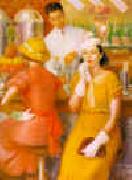 |
William Glackens
|
|
1870-1938
William Glackens Galleries
William James Glackens (March 13, 1870?CMay 22, 1938) was a U.S. realist painter.
Glackens studied at the Pennsylvania Academy of the Fine Arts and later moved to New York City, where he co-founded what came to be called the Ashcan School art movement. This group of artists, dubbed by the press "the Eight Independent Painters" or The Eight, chose to exhibit their works without pre-approval by the juries of the existing art establishment. He became known for his dark-hued paintings of street scenes and daily life in the city's neighborhoods. His later work was brighter in tone, and showed the influence of Renoir. During much of his career as a painter, Glackens also worked as an illustrator for newspapers and magazines in Philadelphia and New York City. |
|
|
|
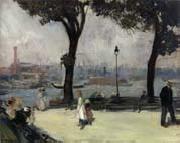 |
William J.Glackens
|
|
March 13.1870-May 22.1938,American painter and illustrator. He graduated in 1889 from Central High School, Philadelphia, where he had known Albert C. Barnes, who later became a noted collector of modern art. He became a reporter-illustrator for the Philadelphia Record in 1891 and later for the Philadelphia Press. In 1892 he began to attend evening classes in drawing at the Pennsylvania Academy of Fine Arts, studying under Thomas Anshutz. In the same year he became a friend and follower of Robert Henri, who persuaded him to take up oil painting in 1894. |
|
|
|
|
|
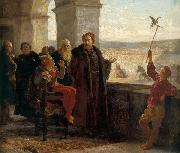 |
Wojciech Gerson
|
|
(1831 - 1901) was a Polish painter and professor.
Born in Warsaw, Gerson enrolled at the Warsaw Fine Arts Academy and graduated with honorable mention and a scholarship to St. Petersburg Academy of Arts where he studied historical painting under A. T. Markov. He graduated from St. Petersburg with a silver medal and returned to Warsaw. He left for Paris in 1850 and studied under Leon Cogniet.
He travelled back to Warsaw in 1858, where he would live for the rest of his life. Gerson began to teach art in his own workshop in 1865. He trained many future Polish artists such as J??zef Chełmo??ski, Leon Wycz??łkowski, Władysław Podkowi??ski, and J??zef Pankiewicz. He was made a professor for the St. Petersburg Fine Arts Academy in 1878.
Gerson also worked as an architect and art critic. He is known for his paintings of patriotism, country life, and mountain landscapes. Gerson died in Warsaw, aged 70. |
|
|
|
 |
ZAIS, Giuseppe
|
|
Italian painter, Venetian school (b. 1709, Canale d'Agordo, d. 1789, Venezia) |
|
|

